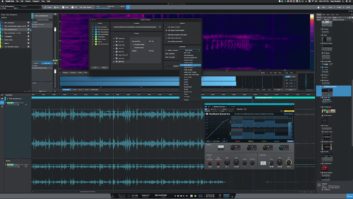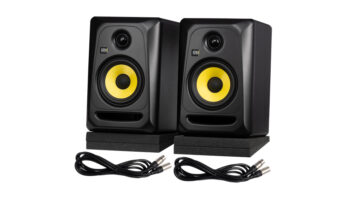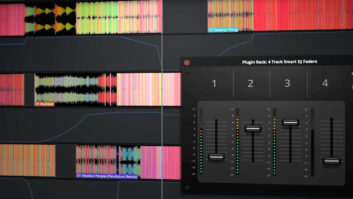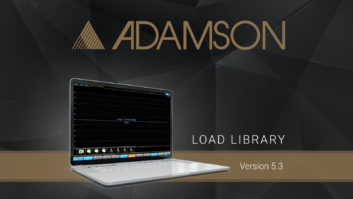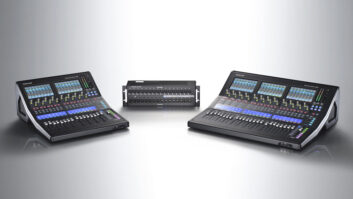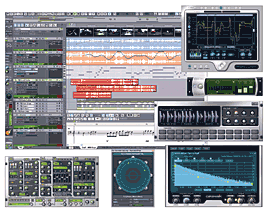
It was just two years ago when Cakewalk released SONAR 4 to rave reviews. SONAR 4 concentrated heavily on surround, boasted a 32-bit audio engine and supported any sample rate, among other features. To keep up with the competitive and evolving DAW world, Cakewalk has now released SONAR 5, which offers some attractive new features, including Roland V-Vocal VariPhrase, Perfect Space Convolution Reverb, five new virtual instruments and BitBridge, to name a few.
The Cakewalk SONAR 5 workspace features audio and MIDI tracks, and various plug-ins.
Cakewalk’s biggest upgrade to SONAR 5 is a double-precision, 64-bit, floating-point engine on 32- and 64-bit native systems. Since the release of Mac OS X “Tiger,” the industry has been heading toward 64-bit processing, but it has never really capitalized on that technology until now. As the first true 64-bit DAW, SONAR 5 brings Windows users to the forefront of digital audio.
To take full advantage of the 64-bit architecture, AMD provided a powerhouse 64-bit processor machine running Windows XP x64 that includes two Dual-Core AMD Opteron Processor 280s running at 2.41 GHz. The AMD machine is configured as a dual-boot system, allowing me to launch either Windows XP Professional 32-bit or Windows XP x64 (64-bit). The hard drive setup included an OS drive partitioned for Windows XP Professional 32-bit and x64. A 300GB data (audio) drive was set up in a RAID 0 fashion for speed and reliability.
Because SONAR 5 ships with 32- and 64-bit versions on a DVD, I was prompted to install the 64-bit version on Windows XP x64. [Eds. note: Version 5.2 update patch is now available.] You don’t need a 64-bit processor or Windows XP x64 to run SONAR 5, but if you do have a 64-bit Intel or AMD processor, there is a fully functioning trial of the official release of Windows XP x64 edition that runs for 120 days.
Cakewalk boasts a 20 to 30-percent performance increase when SONAR 5 is installed on a full 64-bit system. If you are upgrading from SONAR 4 and don’t want to change your current system but still wish to partake in the 64-bit excitement, you can install the 32-bit version and still take advantage of the new 64-bit mix engine. The double-precision, floating-point engine improves calculations during intensive applications, such as sessions that combine heavy automation with virtual instruments, plug-ins and high sample rates; in my experience, this is when most current systems and mixes start to suffer audibly. As for I/O, check Cakewalk’s site and your current interface manufacturer for updated 64-bit drivers. I used an M-Audio 1814 because the company offers a beta download for its FireWire interfaces, and that worked perfectly.
A big perk of 64-bit architecture is the ability to break the RAM barriers. Current 32-bit processor applications max out at 3 GB. The new limit with Intel EM64T- and AMD64-based systems is a whopping 128 GB of RAM. This is big news for those of you who employ virtual instruments, samplers and loops. Instead of streaming the data off of hard disks, you can load instruments and audio clips into RAM, allowing SONAR to access the data more quickly. The 4 GB that shipped with the AMD system was sufficient for all my applications.
SESSION FENG SHUI
Some of the best that SONAR 5 offers has to do with workflow enhancement and innovative ways of processing audio. Features include a new way of inserting plug-ins over clips of audio or MIDI via the FX Bin. By selecting any audio or MIDI clip and right-clicking, you can insert real-time effects (with automatic delay compensation) directly over the clip instead of the whole track — a much more efficient way of processing audio than in the past. Once one or more plug-ins have been inserted, they can be easily accessed; simply click on the “FX” flag within the clip.
You can view waveforms for buses and synth tracks, providing a visual of the envelope with the ability to scale up or down, just like audio tracks. This proved to be a nice preview before printing virtual instruments to an audio track. Also, SONAR users will instantly notice the new peak markers following playback in the Track View screen. Peak markers are an indispensable way of detecting overs and peaks; a numeric value is conveniently displayed next to the transient. I got so used to this that after returning to my other DAW, I really missed this feature. Automation can now be edited with an intuitive new feature called Add Nodes at Selection. This means that right-clicking on any selection of time can conveniently add nodes for simple level changes.
As for MIDI upgrades, there is a new Inline Piano Roll view, allowing you to edit note and controller events in the Track View screen. This allows you to conveniently work on audio and MIDI clips within the same view, definitely a bonus for users with only one video monitor. Cakewalk has also updated the MIDI FX plug-ins, and step recording has been improved — there are now immediate visuals of what’s being recorded and it offers unlimited backstep deleting.
VOCAL MASSAGE
SONAR 5 now ships with Roland’s V-Vocal, which incorporates VariPhrase technology, allowing you to alter tempo and pitch. V-Vocal creates a clip of your selected audio, analyzes it and defaults to the Pitch View screen over a scale. Corrections to vocals can be made automatically, manually or with the scale. Move a selection up or down the scale; the original pitch remains red while the new pitch is yellow.
The LFO tool proved to be very effective, allowing me to visually adjust the amount of scale modulation or remove the original vocal modulation. You can draw your own modulation with control over amplitude and wavelength. Once the pitch is corrected, V-Vocal can also adjust timing of any words or phrases. By selecting the Time tab at the lower-left corner, you can drag words or phrases and change their position without affecting other words or phrases. V-Vocal also allows you to work within the Formant and Dynamic views, where you can use a pencil tool, line tool or the LFO tool to change the waveform’s envelope from subtle to ridiculous. With all this flexibility, V-Vocal isn’t just for vocals; I used it on guitar solos and on a fretless bass to correct tuning problems and a few performance mistakes.
PLUG-INS AND INSTRUMENTS GALORE
If virtual instruments and samplers are your thing, SONAR 5 now includes the PSYN II subtractive synth, Pentagon I vintage analog synth, Roland GrooveSynth, SFZ SoundFont sampler and the RXP REX Player groove box. I experimented with the GrooveSynth and was pleasantly surprised by all of the authentic sounds, including the original 808 and 909 kits. However, I did experience an issue where the GrooveSynth did not work within a session running at 88.2 kHz.
As for plug-ins, all of my favorites from SONAR 4 are still available, including the Cakewalk and Sonitus suite. The popular Lexicon Pantheon Reverbs were always a favorite, but there’s a new ‘verb in town: the Perfect Space Convolution Reverb. The integrated 340 sampled impulses include acoustic spaces and hardware reverbs with 64 ms of low-latency monitoring and 64-bit processing. While the Pantheon ‘verbs are surround-compatible, Perfect Space provides more realistic and experimental spaces, including the inside of pianos, acoustic guitars and bass amps.
One of the drawbacks of the 64-bit leap is the inability to run Legacy plug-ins and instruments. However, Cakewalk has addressed this issue with SONAR’s BitBridge, allowing you to incorporate 32-bit instruments and plug-ins into the 64-bit realm. (The 5.2 update includes support for new VST 2.4 extensions and shell support for Waves VST plug-ins.) With BitBridge, not only can you still use your old effects and instruments, but you can also take advantage of the extended RAM allocation afforded within the 64-bit architecture — a sweet deal.

Track View and Bus Preview showing peak readings on the timeline (red).
PLAYING WITH SONAR 5
During my mixing sessions, the machine running fully at 64 bits (processors, OS and drivers) was impressive. The first session was loaded with 35 audio tracks running at 24-bit/88.2kHz and a slew of plug-ins: 10 Sonitus gates, 15 Sonitus compressors, five bus sends feeding three Lexicon Pantheon reverbs, two VST Perfect Space Convolution Reverbs and heavy automation across most tracks. The CPU usage was at 10 percent and disk at 50 percent with the buffer set in the middle (90 ms of latency). So I loaded an instance of the Pentagon I synth and PSYN II subtractive synth, and finally the CPU meter jumped to 40 percent. I rebooted and launched the 32-bit Windows XP OS, and the CPU usage jumped to 20 and 60 percent with the Pentagon I synth. The 64-bit advantage is undeniable, and it’s certainly the way to go with SONAR 5.
But the advantage doesn’t stop with just performance. Listening to the 64-bit system also proved to be satisfying and impressive. My mix had more detail and depth, and the image was better than when I played it on other DAWs. I chalked this up to the extra dynamic headroom provided by the 64-bit system. The mix wasn’t as one-dimensional — rather, it was closer to what I usually encounter by summing through an analog desk. To be honest, it was the best that mix has ever sounded on a DAW.
To audition the 64-bit mix engine on and off (under Options/Audio), I solo’ed up a bus return with a Sonitus Phase, Sonitus EQ, Lexicon Pantheon Reverb and Sonitus Compressor. Both 32- and 64-bit systems shared a noticeable improvement with the 64-bit mix engine on. The definition was better and the Lexicon Pantheon reverb tail was smoother. The overall sound of the bus with all of the plug-ins combined was fuller, proving to me that even 32-bit users can take advantage of the new 64-bit mix engine.
TAKE THE LEAP
Building on the success of its predecessor, SONAR 5 Producer Edition is definitely jammed with everything needed from a DAW. But for the aspiring engineer who doesn’t need all the extra bells and whistles, Cakewalk offers Studio Edition, which leaves out a few key features such as Roland V-Vocal, multiformat surround support, the Lexicon Pantheon Reverb, the Perfect Space Convolution Reverb and some instruments (PSYN II synth, Pentagon I synth and the RXP REX Player groove box).
The way I see it, the future of audio on a computer is here. The 64-bit leap is audible, improves performance and is the next logical step. Even if you remain in the 32-bit realm, you can still take advantage of the 64-bit mix engine, but it was with the full-blown 64-bit system that my mixes sounded best. You don’t even pay a plug-in price; Cakewalk eases the 64-bit transition by allowing you to use your current 32-bit effects and instruments via BitBridge.
If SONAR 5 is installed on a 64-bit machine, the ability to break the RAM barriers is going to be very satisfying for those who rely on virtual instruments, high plug-in counts and high sample rates. V-Vocal, Perfect Space Convolution Reverb and the 64-bit architecture alone justify the upgrade. Also attractive is the price, which is lower than the cost of SONAR 4.
Prices: SONAR 5 Producer Edition, $799; Studio Edition, $479.
Cakewalk, 617/423-9004, www.cake walk.com.
Phoenix-based Tony Nunes is an audio engineer and daddy-to-be, for the second time.
